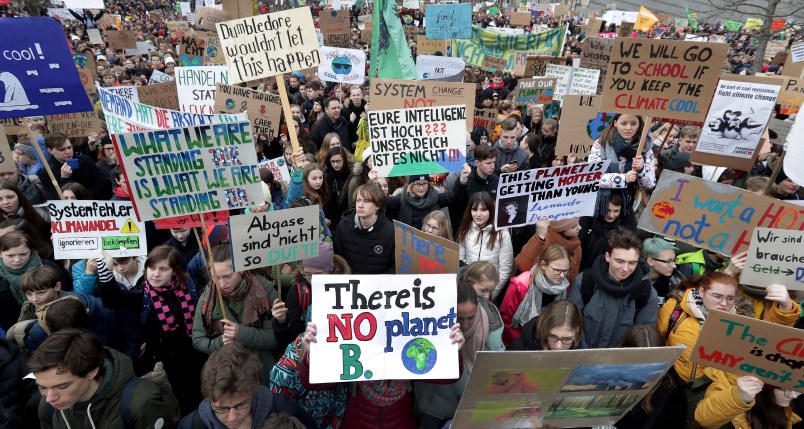BERLIN (AP) — From the South Pacific to the edge of the Arctic Circle, students mobilized by word of mouth and social media are skipping class to protest what they see as the failures by their governments to take tough action against global warming.
Friday’s rallies were one of the biggest international climate change actions yet, involving hundreds of thousands of students in more than 100 countries around the globe.
The coordinated “school strikes” were inspired by 16-year-old Swedish activist Greta Thunberg, who began holding solitary demonstrations outside the Swedish parliament last year.
Since then, the weekly protests have snowballed from a handful of cities to hundreds, fueled by dramatic headlines about the impact of climate change during the students’ lifetime. Scientists have backed the protests, with thousands in Britain, Finland, Germany and the United States signing petitions in support of the students.
Thunberg, who has been nominated for the Nobel Peace Prize, said at a rally in Stockholm that the world faces an “existential crisis, the biggest crisis humanity ever has faced and still it has been ignored for decades.”
“And you know who you are, you that have ignored this,” she said.
Across the globe, protests big and small urged politicians to act against climate change while also highlighting local environmental problems:
— In India’s capital of New Delhi, schoolchildren protested inaction on climate change and demanded that authorities tackle rising air pollution levels in the country, which often far exceed World Health Organization limits.
— In Paris, teenagers thronged the cobblestoned streets around the domed Pantheon building. Some criticized French President Emmanuel Macron, who sees himself as the guarantor of the landmark 2015 Paris climate accord but is criticized by activists for being too business-friendly and not ambitious enough in efforts to reduce emissions.
Raphael Devautour, high school student said it was his first protest. “We can feel that something is happening,” he said. “When the youths start acting, it get things moving. We saw it in 1968.”
— In South Africa’s capital, Pretoria, one protester held a sign reading “You’ll Miss The Rains Down in Africa.” Experts say Africa, with its population of more than 1 billion people, is expected to be hardest hit by global warming even though it contributes least to the greenhouse gas emissions that cause it.
— Thousands marched in rainy Warsaw and other Polish cities to demand a ban on burning coal, a major source of carbon dioxide. Some wore face masks as they carried banners that read “Make Love, Not CO2.”
— Speakers at the U.S. Capitol in Washington stood behind a banner that said “We don’t want to die.”
— Protests in Madrid and more than 50 other Spanish cities drew thousands. The country is vulnerable to rising sea levels and rapid desertification .
— In Berlin, police said as many as 20,000 protesters gathered in a downtown square, waving signs such as “March now or swim later” before marching through the German capital to Chancellor Angela Merkel’s office.
Carla Reemtsma, a 20-year-old student who helped organize the protest in Berlin, said she’s part of about 50 WhatsApp groups devoted to discussing climate change.
“A lot happens on social media because you can reach a lot of young people very quickly,” she told The Associated Press.
Azalea Danes, a student at the Bronx High School of Science, wasn’t a climate activist until two weeks ago when she read about Thunberg’s efforts. Now she is one of the top organizers of the youth climate strike in New York City, where she hopes thousands will rally in three places later Friday.
That shows how these protests are organized from the bottom up, she said.
Volker Quaschning, a professor of engineering at Berlin’s University of Applied Sciences, said it was easy for politicians to belittle students.
“That’s why they need our support,” he said. “If we do nothing, then parts of this planet could become uninhabitable by the end of the century.”
But some politicians praised the students. Danish Prime Minister Lars Loekke Rasmussen showed up at a protest in Copenhagen and tweeted Friday “we must listen to the youth. Especially when they’re right: the climate must be one of our top priorities.”
Scientists have warned for decades that current levels of greenhouse gas emissions are unsustainable, so far with little effect.
In 2015, world leaders agreed in Paris to a goal of keeping the Earth’s global temperature rise by the end of the century well below 2 degrees Celsius (3.6 degrees Fahrenheit) compared with pre-industrial times.
Yet the world has already warmed by 1 degree C since then and is on track for an increase of 4 degrees Celsius, which experts say would have far-reaching consequences for life on the planet
In Germany, environmental groups and experts have criticized government plansto continue using coal and natural gas for decades to come.
Quaschning, one of more than 23,000 German-speaking scientists to sign a letter of support this week, said Germany should stop using all fossil fuels by 2040. This would give less-advanced nations a bit more time to wean themselves off coal, gas and oil while still meeting the Paris goal globally.
“This is going to require radical measures and there isn’t the slightest sign of that happening yet,” said Quaschning.
In Stockholm, Thunberg predicted that students won’t let up their climate protests.
“There are a crisis in front of us that we have to live with, that we will have to live with for all our lives, our children, our grandchildren and all future generations,” she said. “We are on strike because we do want a future.”






